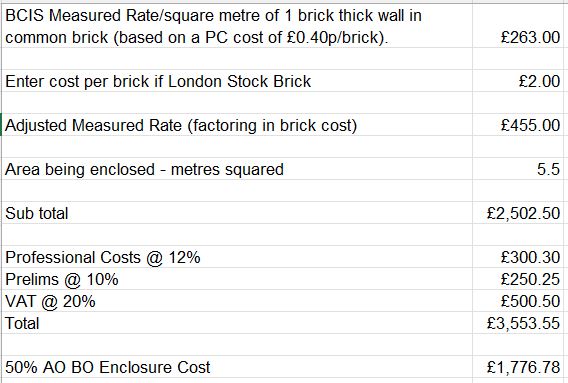Understanding Section 11(11) of the Party Wall Act: Enclosure Cost Payments
Tuesday, 7th January 2025
Party Wall Questions | Party Walls | Surveying
What is Section 11(11) of the Party Wall Act?
Section 11(11) of the Party Wall Act addresses the financial aspect of enclosure. This section is crucial for property owners who are planning to build or alter a party wall and need to understand the implications of the costs involved. Enclosure costs arise when one property owner (known as the “Building Owner”) builds a wall that is later used by an adjoining property owner (known as the “Adjoining Owner”) as part of their own construction project.
The most common situations where this arises is where a parapet wall at roof level has been raised in brick to form a loft extension (either dormer or mansard) or where the party wall has been underpinned to form a basement extension.
Calculating Enclosure Cost Payments
There are generally three methods used to calculate the quantum of payments under Section 11(11) of the Party Wall Act. Each method provides a way to determine a fair amount that the Adjoining Owner should pay to the Building Owner for the benefit of using the wall.
Method 1: Contractors’ Tenders
The first method involves referencing the contractors’ tenders from the party who previously undertook the work. This approach is straightforward and involves obtaining the actual costs incurred by the Building Owner when constructing the party wall. The contractors’ tenders provide a detailed breakdown of the expenses, including labour, materials, and other relevant costs.
This method ensures transparency and accuracy, as it relies on real data from the original construction work. The Adjoining Owner can review the contractors’ tenders to verify the costs and ensure that the amount they are asked to pay reflects the true value of the work done.
Section 11(11) confirms that the the sum payable is to be calculated “at the time when that subsequent use is made” so if there’s a gap between the wall being built and the Adjoining Owner making use of it, the contractors’ tenders must be indexed accordingly.

Method 2: BCIS Industry Measured Rates
The second method for calculating enclosure cost payments is by referencing BCIS (Building Cost Information Service) industry measured rates. BCIS provides a comprehensive database of construction costs, which is widely recognised and used within the industry. These rates are updated regularly to reflect current market conditions and provide a standardised measure for various types of construction work.
Using BCIS industry measured rates offers a practical and efficient way to calculate enclosure costs, especially when detailed contractors’ tenders are not available. This method ensures that the payment amount is based on established industry standards, which can help prevent disputes between the Building Owner and the Adjoining Owner.
There are however, no completely established rules for what is and isn’t included in a calculation and opinions differ between surveyors (a typical example is whether there should be an allowance of scaffolding for an enclosure at roof level).

Method 3: Quantity Surveyor’s Assessment
In very complex situations, a further method involves the instruction of a quantity surveyor to assess the enclosure costs. Quantity surveyors are experts in construction costs and contracts, and their role is to provide an independent and professional evaluation of the expenses involved.
When a quantity surveyor is brought in, they will conduct a thorough analysis of the construction work, considering factors such as the scope of the project, quality of materials, and any unique challenges that may have affected the costs. This method is particularly useful for large-scale or intricate projects where standard rates or contractors’ tenders may not fully capture the true value of the work done.
Choosing the Right Method
Deciding on the appropriate method for calculating enclosure cost payments depends on the specifics of the construction project and the availability of cost data. In many cases, contractors’ tenders provide the most accurate reflection of the expenses incurred. However, when such data is not accessible, BCIS industry measured rates offer a reliable alternative. For particularly complex projects, the expertise of a quantity surveyor can ensure a fair and comprehensive assessment.
Conclusion
Understanding Section 11(11) of the Party Wall Act and the methods for calculating enclosure payments is crucial for both Building Owners and Adjoining Owners. By choosing the right method and ensuring transparency in the cost calculations, both parties can avoid disputes and maintain a positive relationship throughout the construction process.
If you are involved in a project that affects a party wall, it is advisable to seek professional guidance to navigate the intricacies of the Party Wall Act.
A good party wall surveyor will have strong lines of communication with both owners rather than calculating in secret and just putting the figure in the resulting award (which can then only be challenged by way of a Court Appeal).
